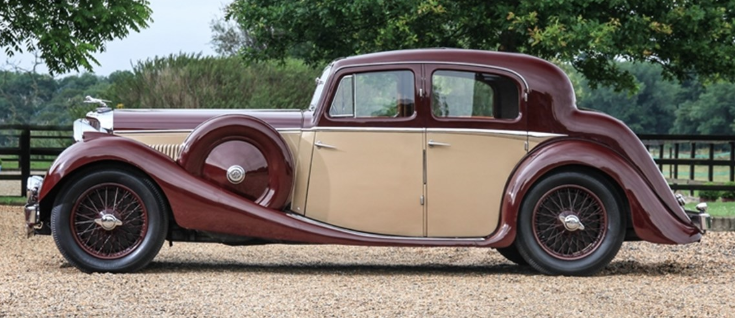(I wrote about Jaguar Mark VII styling here, dealing with Lyons' transition to postwar shapes.)
The images below cover the period 1935 to the late 1950s. During that period Jaguars carried several model names, some indicating redesigned bodies, others having more to do with less obvious changes. References are as follows: Prewar SS Jaguar 1.5, 2.5, 3.5 lire models as well as the postwar "Mark IV," a retrospective designation, (roughly 1935-1949) are treated here. The Mark V, produced 1948-1951, can be linked here. Information on Marks VII (produced 1950-1956) and VIII (produced 1956-1958) can be found here and here, respectively. There also was a Mark X produced 1958-1961 using the same body as the Mark VIII, but it is not treated here due to that similarity.
Unless noted otherwise, images below are of cars listed for sale.
1937 SS Jaguar 2.5 Litre Saloon
The feature under discussion is the profile of the after part of the roof. Its form is that of a large-radius curve that transitions to the vertical and slightly beyond where the roof joins the lower car body at the trunk (boot).
Rear quarter view showing the back window ("backlight" in the jargon of car stylists). Its rounded sides are retained for all the designs shown below -- another key brand identification feature.
1948 Jaguar Mark IV Sports Saloon
Here and below is a 1.5 lire model having a shorter hood than the 2.5 and 3.5 variants. But the body abaft of the cowling is the same. The design is a carryover from prewar SS Jaguars such as the one shown in the top images.
1950 Jaguar Mark V 3.5 Saloon
The first Jaguar postwar saloon design. The front door cut and some other details look about the same as on the prewar models. The passenger compartment "greenhouse" (another styling term) is new, yet its aft "tuck" is as before.
1955 Jaguar Mark VII M Saloon
The Mark VII Jaguar has an integral, postwar type body, though the greenhouse greatly resembles that of the Mark V.
The backlight is slightly taller than before.
1958 Jaguar Mark VIII - photo via RM Sotheby's
Mark VIIIs and Xs are essentially facelifted Mark VIIs.
Finally, Lyons saw to it that postwar Jaguar XK120 Fixed Head Coupé sports cars had roofs with the same characteristics found on the saloons. Photo via RM Sotheby's.











1 comment:
Later copied on the 1994 Chrysler New Yorker.
https://www.flickr.com/photos/29997762@N05/33391487344/
Post a Comment